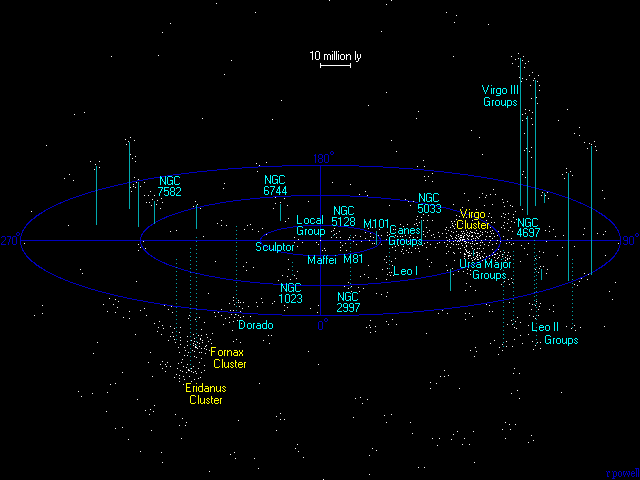Virgo Cluster
The Virgo Cluster is a cluster of galaxies located approximately 59 ± 4 million light-years (18.0 ± 1.2 Mpc) away. in the direction of the constellation Virgo. It contains some 1,300 known galaxies, although there may be as many as 2,000, and forms the central region of the Local Supercluster, in which the Local Group is also found. Its mass is estimated to be 1.2×1015 MS out to about 8 degrees from the center of the cluster, which is equivalent to a radius of about 2.2 Mpc.
Many of the bright galaxies in this cluster, including the giant elliptical galaxy Messier 87, were discovered in the late 1770s and early 1780s and later included in Charles Messier's catalogue. Described by Messier as starless nebulae, their true nature would not be discovered until the 1920s.
The cluster subtends a maximum arc of about 8 degrees centered on the constellation Virgo, and many of its galaxies can be seen with an amateur telescope. Its brightest member is the giant elliptical galaxy M49, but the most notable and famous is the galaxy M87, located at its center.

Structure and composition
Virgo is quite heterogeneous in its mix of spiral and elliptical galaxies. As of 2004, the distribution of spirals in the cluster is thought to be a prolate filament, about 4 times as long as it is wide, stretching along the line of sight from the Milky Way. Elliptical galaxies are more concentrated towards the center than the spirals, a number of which are also characterized by low atomic hydrogen content compared to other non-cluster galaxies of the same type.
The cluster is an aggregate of several different subgroups centered respectively on the galaxies M87 (known as Virgo A), M86 (which some authors consider to be part of M87) and M49 (known as Virgo B, although there are certain doubts as to whether this galaxy belongs to this group). Of them, the dominant one is the first, with an approximate mass of 1014 solar masses and characterized by being composed of a mixture of elliptical, lenticular, and gas-poor spiral galaxies. It is roughly an order of magnitude more massive than the other two subgroups.
Virgo A and Virgo B are in the process of getting closer to eventually merge into a single cluster.
In addition, there are several groupings of galaxies close to those mentioned above: Virgo C (proposed by some authors and centered on the galaxy M60), NBV (Cloud of low velocity, also suggested and whose most notable member is the giant spiral galaxy NGC 4216), Cloud N, Cloud S (both composed almost entirely of spiral galaxies) which also appear to be in the process of approaching and eventually merging with the main cluster, Cloud E (which is at the same distance as Virgo A), and finally Cloud M, Cloud W, and Cloud W'(which seem to be independent of the cluster and to be background galactic groupings, especially the second one), in addition to many galaxies located relatively close to the cluster that are thought to end up being attracted by its gravity in the future (for example, the Coma I group of galaxies) becoming part of it, all of which shows that Virgo is a dynamic galaxy cluster young entity and still in formation, like others such as the Coma cluster.
The great mass of the cluster is indicated by the peculiar high velocities of many of its galaxies, in some cases reaching 1600 km/s with respect to the center of the cluster, and by having slowed the recession of its Local Group by approximately 10 percent.
Intergalactic medium
As in other rich galaxy clusters, the intergalactic medium of the Virgo cluster is filled with a plasma at very high temperatures (millions of Kelvin) detectable thanks to its X-ray emission, in addition to a relatively large number of stars (about 10% of the total star mass in the cluster)—including a number of planetary nebulae—thought to have been ejected from their galaxies due to gravitational interactions with other galaxies, including star-forming regions, and—although the evidence was initially controversial—globular clusters, perhaps largely ripped from dwarf galaxies.
Notable members of the Virgo Cluster
The following are the brightest and/or notable galaxies of the Virgo cluster both in the Messier Catalog and in the NGC Catalog, and the subgroup to which they belong:
Messier catalogue
M49 (Virgo B (?)), M58 (Virgo A), M59 (Virgo A), M60 ( Virgo A), M61 (Cloud S), M84 (Virgo A), M85 (Virgo A), M86 (Virgo A (?)), M87 (Virgo A), M88 (Virgo A), M89 (Virgo A), M90 (Virgo A), M91 (Virgo A), M98 (Cloud N), M99 (Cloud N), and M100 (Virgo A).
NGC Catalog
(See for all of them references 7 and 20): NGC 4216 (Virgo A), NGC 4365 (Virgo B), NGC 4388 (Virgo A), NGC 4394 (Virgo A), NGC 4435 (Virgo A), NGC 4438 (Virgo A), NGC 4450 (Virgo A), NGC 4473 (Virgo A), NGC 4526 (Virgo B), NGC 4527 (Cloud S), NGC 4535 (Cloud S), NGC 4536 (Cloud S), NGC 4567 (Virgo A), NGC 4568 (Virgo A), NGC 4636 (Cloud S), NGC 4651 (on the periphery of the cluster, not belonging to any specific subgroup), NGC 4654 (Virgo A).
Map
Contenido relacionado
Charon (satellite)
(33) Polyhymnia
Mars Gravity Biosatellite

